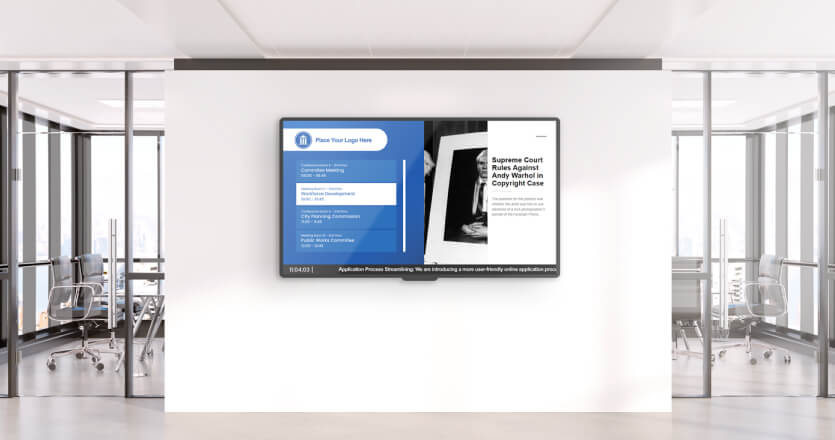Have you ever felt like information travels slower than a sloth moving, highlighting the urgent necessity of an internal communication strategy? Maybe key messages get lost in a sea of emails, or important updates only reach a select few. Considering the fact that effective internal communication is the lifeblood of any organization, you need to craft a strategy that will foster a sense of connection, transparency, and shared purpose amongst employees. But how do you plan a winning communication strategy that keeps everyone informed, engaged, and motivated? This guide will equip you with the knowledge and tools you need to create an effective communication plan within an organization that will empower your workforce and introduce you to digital signage, the best tool for it.
What is an internal communication strategy?
At its essence, an internal communication strategy is the roadmap that guides interactions within a business. It encompasses the methods, channels, and tactics used to disseminate information, nurture engagement, and cultivate a cohesive organizational culture.
Why do you need an internal communication strategy?
Now that we have cleared what an internal communication strategy is let’s get down to why you need one. To put it simply, effective communication fuels productivity and innovation. Thus, organizations risk falling prey to confusion, inefficiency, and disengagement without a well-defined internal communication strategy. Given that, a comprehensive strategy not only ensures alignment with business objectives but also empowers employees, fostering a sense of belonging and purpose that drives performance and retention.
What are the 8 types of internal communication?
1. Leadership and top-down communication
Clear, consistent communication from leadership sets the tone for organizational culture and inspires employee confidence. This type of communication is essential for conveying strategic vision, goals, and expectations from upper management to all levels of the organization.
2. Change communication
Guiding teams through periods of change requires transparent communication to manage expectations and mitigate resistance. Effective change communication involves informing employees about the reasons for change, addressing concerns, and providing support throughout the transition process.
3. Crisis communication
Swift and effective communication is crucial during crises to ensure the safety and well-being of employees and stakeholders. Crisis communication involves timely updates, clear instructions, and empathy to manage the situation and maintain trust and confidence in the organization.
4. Information communication
Disseminating essential information, from company policies to procedural updates, keeps employees informed and empowered. Information communication ensures that employees have access to accurate and relevant information to perform their roles effectively and make informed decisions.
5. Bottom-up or two-way communication
Creating channels for feedback and dialogue empowers employees to voice concerns, contribute ideas, and feel valued. Two-way communication fosters a culture of openness and collaboration, where employees feel heard and respected, leading to increased engagement and innovation.
6. Peer communication
Collaboration flourishes when colleagues communicate effectively, sharing knowledge, best practices, and support. Peer communication involves informal interactions, team meetings, and collaborative tools that enable employees to exchange ideas, seek advice, and collaborate on projects.
7. Culture communication
Reinforcing organizational values and celebrating achievements fosters a sense of belonging and cultivates a positive workplace culture. Culture communication involves storytelling, recognition programs, and events that promote organizational values, build morale, and strengthen employee engagement.
8. Campaign communication
Initiatives such as employee engagement programs or wellness campaigns rely on targeted communication strategies to inspire participation and drive results. Campaign communication involves planning, promoting, and executing initiatives that align with organizational goals and resonate with employees’ interests and needs.

What are the 7 steps to create an internal communication strategy?
1. Summarize the situation
Conduct a comprehensive assessment of current communication practices, identifying strengths, weaknesses, and areas for improvement. Gather feedback from employees through surveys, focus groups, and interviews to gain insights into their communication preferences and pain points.
2. Determine your desired outcome
Define clear objectives aligned with organizational goals, whether it’s improving employee engagement, enhancing transparency, or fostering innovation. Establish key performance indicators (KPIs) to measure the success of your communication efforts and track progress over time.
3. Define your audience
Understand your audience segments’ diverse needs, preferences, and communication styles, tailoring strategies and messages accordingly. Create employee personas based on demographics, roles, and communication preferences to guide your targeting and messaging efforts.
4. Develop your message
Craft compelling messages that resonate with your audience, conveying information clearly, concisely, and in a tone that reflects organizational values. Use storytelling, visuals, and examples to make your messages relatable and engaging, capturing employees’ attention and inspiring action.
5. Decide what your strategy is and what channels and tactics you’ll use
Select appropriate communication channels and tactics, leveraging various mediums to effectively reach diverse audiences. Consider the strengths and limitations of each channel, as well as the preferences and accessibility of your target audience, when designing your communication plan.
6. Populate Your communications calendar
Establish a cadence for communication initiatives, ensuring consistent engagement and timely updates. Create a communications calendar outlining the timing, frequency, and content of your messages, taking into account key events, milestones, and deadlines that may impact your communication schedule.
7. Measure your progress
Implement metrics to track the effectiveness of your communication strategy, gathering feedback and data to inform iterative improvements. Monitor KPIs such as employee engagement scores, communication channel effectiveness, and message reach and resonance to evaluate the impact of your efforts and make data-driven decisions to optimize your communication strategy over time.
The don’ts of an internal communication strategy!
- One message is not enough: Avoid relying on a single communication method or message to convey important information. Employ redundancy to ensure critical messages reach all stakeholders.
- Do not depend on a single communication channel: Embrace a multi-channel approach to communication, catering to diverse preferences and ensuring messages are accessible across various platforms.

Why digital signage is the best internal communication tool
Imagine vibrant screens strategically placed in communal areas, corridors, and break rooms, broadcasting important announcements, company news, and motivational messages. With Yodeck’s digital signage, this vision becomes a reality. Yodeck offers a comprehensive solution for transforming static spaces into dynamic communication hubs, empowering organizations to deliver timely, relevant, and visually compelling content that informs, inspires, and aligns employees across all levels and departments.
Why Yodeck?
Yodeck’s commitment to user-friendly design, comprehensive features, scalability, and affordability makes it the ultimate choice for businesses seeking to enhance their internal communication strategies through dynamic digital signage.
Some final thoughts
Effective internal communication is not just a strategy; it’s a competitive advantage. By crafting a comprehensive communication strategy and embracing innovative tools like Yodeck digital signage, organizations can break through communication barriers, foster collaboration, and cultivate a culture of engagement that pushes them toward success in an ever-evolving marketplace. So, take the opportunity to transform your organization’s communication landscape and start moving toward greater connectivity, productivity, and prosperity.
